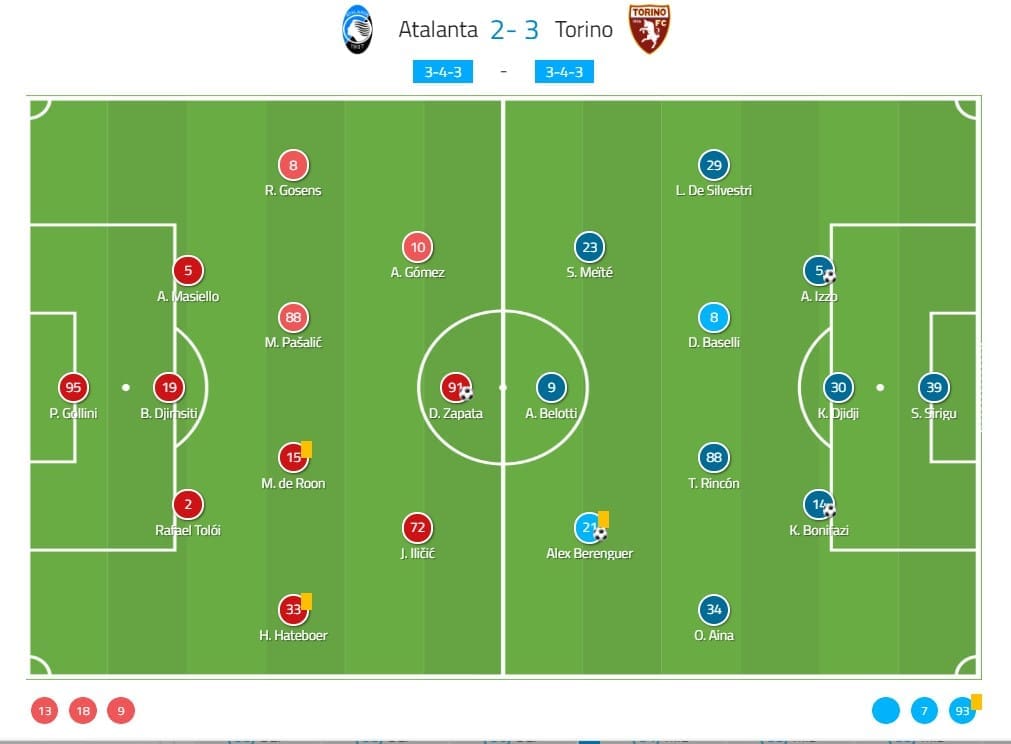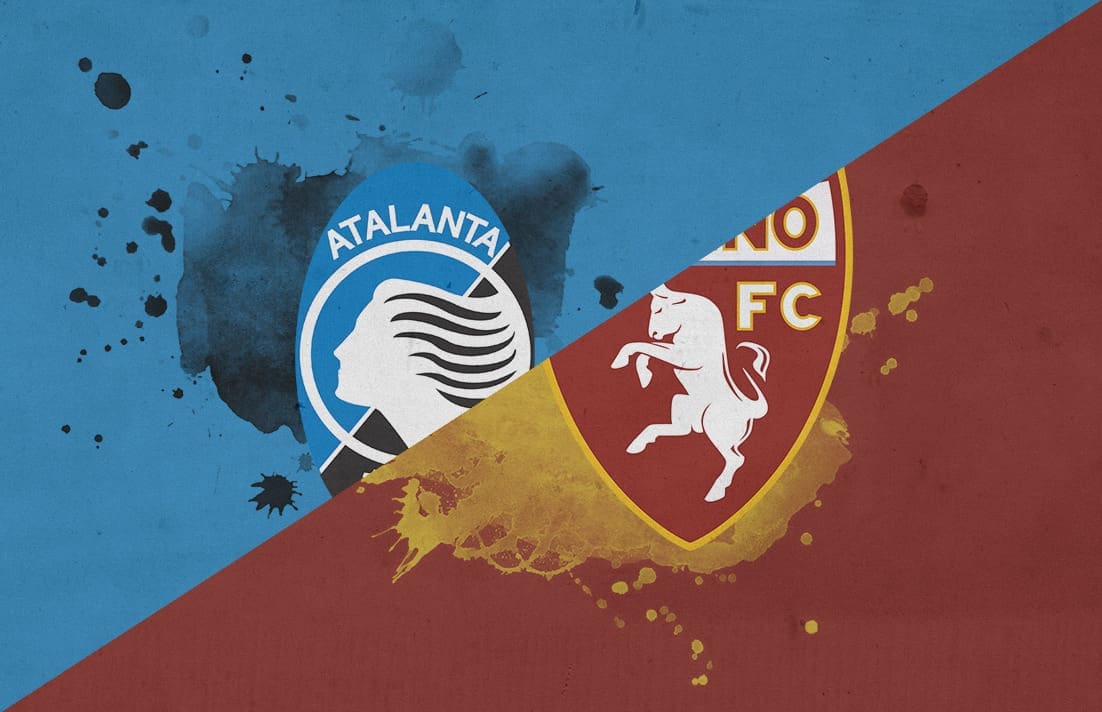Serie A becomes a home of many exciting battles. After a thrilling game between Juventus and Napoli earlier, one of the most interesting games in the second round turned out to be between Atalanta and Torino. The teams offered a show that was hard to be neglected and ended up scoring five goals in a breathless spectacle.
There was no time for blinking as Atalanta’s well known attacking strategy took place once again. This, though, wasn’t enough as Torino were waiting patiently and took advantage of their chances, allocating their opponent’s defensive vulnerability.
In this tactical analysis, we will break down both team’s tactics and explain why Atalanta had struggles despite the dynamic performance.
Lineups

Both teams went out with pretty similar formations although in practice there could be seen many differences in their approach.
Gasperini once again decided to rely on a back-three, with the intense use of the wing-back Hateboer. He, along with Tolói, De Roon and Iličić would be responsible for circulating the ball mostly on the right flank.
On the other side, Torino were lined up with a back-three as well, which would be extremely active in the teams’ attacking actions throughout the game. This would be of great help as the captain Belotti would often find himself isolated and unable to contribute in a great way.
Atalanta’s attack-minded approach
Atalanta started the game with an extremely high pace. They were creating loads of opportunities and used their attacking force to nullify any effort that the Torino players were putting into gaining back possession and building up.
La Dea were trying to use a short sequence of passes during their build-up and tended to transition the ball quickly from their own half to the final third. They were attacking mainly though the right flank where they had players like Hateboer and Iličić who were among the main ones responsible for Atalanta’s attacking ventures.


Gasperini’s approach has always been committed to using the wings in order to distribute the ball to the opposition’s half. This time though he overcommitted the actions on the right, which led to leaving gaps on the left and being noticeably less efficient out there. A whole 40% of the team’s attacks were created on the right-hand side. This has actually affected their defensive actions out there negatively, which was perfect for Torino who would use the same flank as a way to break into Atalanta’s half.


Along with Iličić who would occasionally drop deeper to pick up the ball and be around the box in a split second, the other deadly threatening player was Duván Zapata. His movement on- and off-the-ball was giving his markers a hard time as they were split between trying to stay well-structured defensively and trying to beat him. Most of the time his ball control would be crucial as it helped him take on his opponents easily and be able to shoot. He managed to dribble successfully five times in the game.
On a few occasions, Atalanta tried to create counter-attacks. They’d use Iličić as the main force using his pace and control to get the ball to the final third and create shooting opportunities. The use of the wing-backs was extremely important as per usual, as, for example, Hateboer would be the main contributor in Atalanta’s passing activities.



Pašalić was a key figure in the rare occasions when the team were retaining possession in the midfield and trying to create the attacks through the middle. His contribution to the equalising goal was noticeable. He sent an impressive through ball to Zapata who scored for 1-1. But what was more notable is Pašalić’s continued off-the-ball movement. He turned out to be a great additional option for the team in attack. In this scenario, even if Zapata wasn’t able to shoot, Pašalić’s run to the box would have given him an option for a pass which could’ve led to a goal anyway.


La Dea’s lack of defensive awareness
Atalanta would often lack defensive awareness in key moments. That’s partly a result of their attack-minded approach which started from the defence itself. Not only were they trying to build-up from the back, but one player of their three-man defensive line would frequently go out and contribute to their attacking actions. Masiello and Tolói would rotate and split their responsibilities going further. This would often break their defensive structure which is the reason they failed to stop their opponents from creating chances.
As already mentioned, another reason for giving Torino that many opportunities is that most of Atalanta’s players weren’t taking care of their defensive responsibilities.

They were applying man-to-man marking which would most frequently work, but it would leave the opportunity for the Torino players to drag their opponents out of position and open spaces. That would happen due to the Atalanta players overcommitting themselves into covering their target-man and not paying attention to the whole defensive structure.

Torino took great advantage of the opposition’s lack of awareness when defending set-pieces. Torino were acting fast when taking set-pieces and were more active when it comes to aerial duels and applying press.
Anyway, when not caught off guard, Atalanta would defend with five players as the wing-backs would drop back, but also rely on additional support by the defensive midfielder. This would often not be enough as the connection between the central-defenders would be too weak. Djimsiti didn’t provide the needed support to Tolói for Torino’s second goal for example. That, combined with a good one-touch combination by the attackers, resulted in Torino equalising.


Atalanta’s central pairing would often leave too much space between each other which would provoke their opponents to exploit it either with an off-the-ball movement or a through ball. Despite this, Torino were doing good in stretching the defensive line out wide before using the central areas to finish the attack.

Torino’s high press and intelligent movement
Torino’s most noticeable strategy was applying high press. They would start their defensive actions from the attacking players and try stopping Atalanta’s build-up. This would often be successful and result in La Dea losing the possession and giving Torino an opportunity to quickly get the ball and immediately attack.
This would affect Atalanta’s build-up on a few occasions as they would retain possession in their defensive third, trying to find an option for a pass. This would often force them to send the ball back to the goalkeeper in order to release the press.

Il Toro were using different methods to build-up. They would most frequently use their left flank but wouldn’t neglect the other areas and wouldn’t miss on an opportunity out there. Once they felt pressured they would either use a long forward ball or try to switch flanks and slow down the tempo. The constant in their attacks would be the players’ off the ball movements. They would rely on creativity and positioning in order to outwit their opponent.

Il Toro’s defensive efforts
Torino would often get caught on a counter. They would find it hard to stop Atalanta when they perform speedy attacks. Their three-man defensive line would often be late during the defensive transition after attacking set-pieces. This would result in chaotic actions and most frequently with a dangerous opportunity for Atalanta in front of the goal.

They would also frequently leave too many gaps for Zapata to exploit. They didn’t provide the needed coverage, keeping in mind his skills on the ball as well as his off-the-ball movement.


Conclusion
As shown in this analysis, Atalanta’s dynamic attacking approach has its benefits as well as its disadvantages. A lot of times they would get carried away with their build-up efforts and lose possession in the blink of an eye, which would result in conceding goalscoring opportunities.
On the other side, Torino showed what it means to wait for the right time and be efficient. The team was focused on taking advantage of their opportunities, trying to compensate for their defensive mistakes. Their back-three needs to improve in terms of timing and positioning in order to allow less space to their opponents.

If you love tactical analysis, then you’ll love the digital magazines from totalfootballanalysis.com – a guaranteed 100+ pages of pure tactical analysis covering topics from the Premier League, Serie A, La Liga, Bundesliga and many, many more. Buy your copy of the August issue for just ₤4.99 here.





Comments